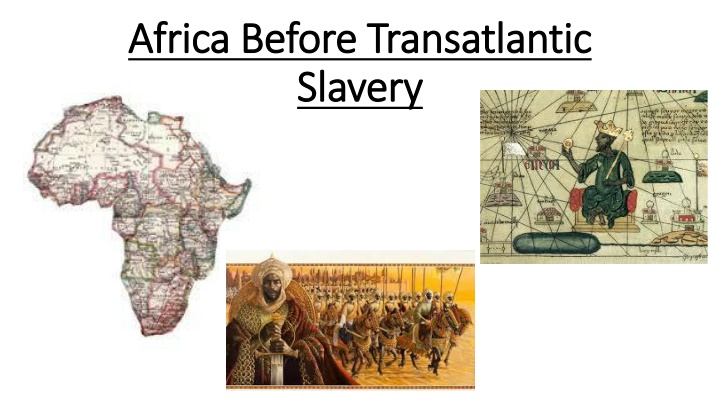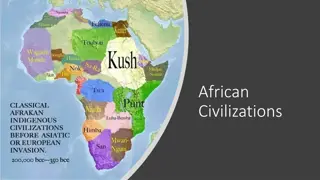Flourishing Civilizations of Pre-Colonial Africa
Explore the rich history of pre-colonial Africa that dispels misconceptions of African inferiority. Discover the advanced civilizations of Egypt, Ghana, Benin, Mali, and Songhay, showcasing achievements in science, technology, trade, and governance.
Uploaded on Sep 07, 2024 | 2 Views
Download Presentation

Please find below an Image/Link to download the presentation.
The content on the website is provided AS IS for your information and personal use only. It may not be sold, licensed, or shared on other websites without obtaining consent from the author.If you encounter any issues during the download, it is possible that the publisher has removed the file from their server.
You are allowed to download the files provided on this website for personal or commercial use, subject to the condition that they are used lawfully. All files are the property of their respective owners.
The content on the website is provided AS IS for your information and personal use only. It may not be sold, licensed, or shared on other websites without obtaining consent from the author.
E N D
Presentation Transcript
Africa Before Transatlantic Africa Before Transatlantic Slavery Slavery
Many Europeans thought that Africa's history was not important. They argued that Africans were inferior (not as good as) to Europeans and they used this to help justify slavery. However, the reality was very different. A study of African history shows that Africa was by no means inferior to Europe. As you can see below, the people who suffered the most from the Transatlantic Slave Trade were civilized, organised and technologically advanced peoples, long before the arrival of European slavers, trying to suggest they were backward peoples.
Egypt Egypt was the first of many great African civilisations. It lasted thousands of years and achieved many magnificent and incredible things in the fields of science, mathematics, medicine, technology and the arts. Egyptian civilisation was already over 2000 years old by the time the city of Rome was built.
Ghana In the west of Africa, the kingdom of Ghana was a vast Empire that spread across an area the size of Western Europe. Between the ninth and thirteenth centuries, it traded in gold, salt and copper. It was like a medieval European empire, with a collection of powerful local rulers, controlled by one king or emperor. Ghana was highly advanced and successful. It is said that the Ghanaian ruler had an army of 200,000 men.
Benin The kingdoms of Benin and Ife were led by the Yoruba people and sprang up between the 11th and 12th centuries. The Ife civilisation goes back as far as 500BC and its people made objects from bronze, brass, copper, wood and ivory. Studies of the Benin show that they were highly skilled in ivory carving, pottery, rope, and gum production.
Mali From the thirteenth to the fifteenth century, the kingdom of Mali spread across much of West and North-East Africa. At its largest, the kingdom was 2000 kilometres wide and there was an organised trading system, with gold dust and agricultural produce being exported north. Mali reached its height in the 14th century. Cowrie shells were used as a form of currency and gold, salt and copper were traded.
Songhay Between 1450-1550, the Songhay kingdom grew very powerful and successful. It had a well organised system of government, a developed currency and it imported fabrics from Europe. Timbuktu became one of the most important places in the world. Libraries and universities were built and it became the meeting place for poets, scholars and artists from other parts of Africa and the Middle East.
Africa and slavery Forms of slavery existed in Africa before Europeans arrived. Some countries in the African continent had their own systems of slavery. People were enslaved as punishment for a crime, payment for a debt or as a prisoner of war. However, African slavery was very different from what was to come later. Most enslaved people were captured in battle. In some cases, enslaved people could work to buy their freedom. Children of enslaved people did not automatically become slaves.























